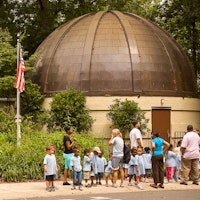The World’s Greatest Classroom? (It’s Waiting Right Outside!)
Discovery Place Nature
In a technology-driven and plugged-in world, parents and caregivers need to be intentional about offering time and space for children to unplug, engage, explore and slow down.
An outdoor classroom which fosters nature-based learning may be just what’s needed.
From the expert designers at Nature Explore Classrooms, “Nature-based learning can foster whole-child development in a gamut of areas: language and literacy, science, social and emotional development, mathematics, body competence, creative arts and visual/spatial learning.”
Not only that, but the behavioral benefits are huge. “Children in outdoor natural settings were more relaxed, happier, less impulsive, more focused, more creative, and better behaved during time spent outdoors.”
This sounds like a win. But how can this be done at home?
Designing an outdoor classroom at home is easy, quick and has little to no cost. Nature-based play is both hugely beneficial and a lot of fun for children. Read on to create your own nature classroom quickly and on a budget.
Location
The first step is finding a location. Most likely, this will be in the back or side yard of the home. Take advantage of small spaces; nooks and crannies; natural separations— like trees and bushes; and defined paths. The most important part of the location is having flexibility and choice. There should be a variety of areas to play; this will encourage a child’s development of autonomous and independent play.
Next, consider what activities you’ll have. The most important thing to offer is choice. A natural classroom lends itself nicely to using those natural materials children love: leaves, dirt, moss, rocks, sticks, etc. Adding in just a few common household items can make a home outdoor classroom remarkably fun for any child.
Water
Water tables are an inexpensive addition to an outdoor classroom. Kids love to play in water; it keeps them busy— and cool in the warmer months. Consider if you can make an investment like this, but it is not necessary.
A water-based play area can easily be constructed. Using large, shallow tupperware bins and various sized cups, an inexpensive— or free— alternative is made. Throw in some cars or plastic dinos and voilà!
Be cautious with any water-based play. Children can drown in only inches of water. Adult supervision is required.
Sound
An outdoor classroom is also a great place to explore sound. Old pots and pans, utensils, keys and cans filled with dry beans can be re-used to make instruments for the outdoors.
Art
Consider what natural canvases there are already outside; plank fences, trees, brick walls— all of these are washable surfaces where children can draw and paint. Or, with only a small investment, a blackboard can be purchased at a home improvement store and mounted outside. Sidewalk chalk, washable paint and brushes are all that’s needed to get started.
Sand or Pebbles
Children love to play in the sand. Consider purchasing or making a small sandbox to encourage fine motor skill development and tactile play. Throw in a shovel and pail, trucks and tractors, or a few hard plastic animals— this one area will keep kids very busy. (Sandboxes can also be filled with small pea gravel to avoid the messiness of sand.)
Messy Play
The last— and most fun— area to incorporate would be for messy play. The more components offered, the better; dirt, water, sticks and leaves, flower petals, etc. Construct a simple horizontal surface and encourage activities like science experiments and cooking. It may look like mud pies and potions, but this type of play is inspiring a depth of creativity and wonder way beyond that.
There is no better teacher for nature than nature herself. Outside, children can observe natural cycles of decay and growth; and the change of seasons throughout the year. The connection between person and nature is a key component to health. Now more than ever, caregivers must be intentional about making outdoor play part of a child’s everyday learning and development.
Ready to get out of the house - or out of your own backyard? Discovery Place Nature located in Charlotte offers yet another way to enjoy nature. From the Butterfly Pavilion and Insect Alley, to Paw Paw Nature Trail and Fort Wild, there is always something to see and explore at the Museum.

